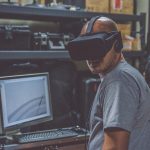Artificial intelligence (AI) and associated technologies are transforming marketing in 2018. Virtual reality (VR), voice search, and AI are increasingly important to marketing campaigns. While all are not ready for full implementation, there are aspects of each that businesses currently see a positive ROI. Voice search is ripe now. AI has already impacted the world but is still … [Read more...] about Modern Day Marketing: AI, VR and Voice Search
AR / VR
Explore the world of virtual and augmented reality. Discover the latest advancements in VR and AR technology and how they are being used in various industries. Learn how to get started with VR and AR and find resources for further learning.
10M Developers Use JavaScript Worldwide, Making It The Most Popular Programming Language
SlashData's presented results from its Developer Economics survey Q4, 2017 in the new State of the Developer Nation report. The report highlights the most important trends for 2018, based on the data from 21,700 developers in 169 countries. For the first time, the State of the Developer Nation report presents the estimate for the number of active software developers using … [Read more...] about 10M Developers Use JavaScript Worldwide, Making It The Most Popular Programming Language
Five Surprising Uses of Virtual Reality in Business
Ah, virtual reality. Huge potential but always seems that next year is the big breakout. There are many interesting case studies, more and more people trying VR for the first time and more hardware being sold every day, but in terms of practical, everyday applications in business, virtual reality is viewed by many as being in the nice to have but not essential category. But … [Read more...] about Five Surprising Uses of Virtual Reality in Business
Virtual Reality for Data Centers – A Competitive Advantage
We work with a host of clients, helping them bring massive spaces, data and physical assets into the digital world. The technology makes it possible for anyone, located anywhere in the world, to explore their space in both 3D and virtual reality (VR). Tens to hundreds of thousands of square feet - and all of the details and assets inside and out - can be at your fingertips … [Read more...] about Virtual Reality for Data Centers – A Competitive Advantage
Digital Marketing in the Virtual Reality Age: An Endless Array of Possibilities
Noting that marketing and outreach efforts have expanded and changed over the course of the past few years would be a gross understatement. Thanks to the rise in digital marketing, companies can connect with consumers in more powerful and direct ways than ever before, reaching them on their smart devices instantly from anywhere, at any time. Thus, it comes as no surprise that … [Read more...] about Digital Marketing in the Virtual Reality Age: An Endless Array of Possibilities
What is virtual reality (VR)?
VR is a computer-generated simulation of a three-dimensional environment that can be interacted with in a seemingly real or physical way. VR is typically experienced using a headset and hand controllers, which track the user’s movements and allow them to interact with the virtual environment.
VR can be used for a variety of purposes, such as gaming, training, and entertainment. It has the potential to create immersive and interactive experiences that are not possible in the real world.
What is augmented reality (AR)?
AR is a technology that superimposes digital information or graphics onto the real world, creating a layered experience. AR can be experienced through devices such as smartphones, tablets, or specialized glasses, which use cameras and sensors to track the user’s movements and display the digital content on top of the real world.
AR is used for a variety of applications, including gaming, education, and advertising. It has the potential to enhance the real world with interactive and informative digital content.
What are the differences between VR and AR?
VR creates a fully immersive, computer-generated environment, while AR enhances the real world with digital information. VR requires specialized equipment, such as a headset and hand controllers, to experience, while AR can be accessed through everyday devices such as smartphones.
VR is typically used for fully immersive experiences, while AR is more commonly used for overlaying digital content onto the real world.
What are some examples of VR and AR?
Examples of VR include video games, educational simulations, and virtual tours. Examples of AR include Pokemon Go, Snapchat filters, and interactive museum exhibits. These are just a few examples of the many possible applications of VR and AR, which are being used in a wide range of industries and contexts.
How can I learn more about VR and AR?
There are many resources available for learning about VR and AR on Datafloq, including online courses, books, and industry events. Online courses, such as those offered by Coursera, edX, and Udacity, can provide a comprehensive overview of the technologies and their applications.
There are also many books on VR and AR that cover various aspects of the technologies and their uses. Attending industry events, such as conferences or meetups, can also be a great way to learn about VR and AR and network with others in the field. It is also possible to try out VR and AR experiences at specialized centers or through demos provided by companies that develop VR and AR technology. This can be a great way to get a firsthand experience of what these technologies are capable of.







